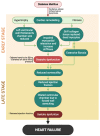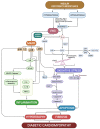The Potential Role of Flavonoids in Ameliorating Diabetic Cardiomyopathy via Alleviation of Cardiac Oxidative Stress, Inflammation and Apoptosis
- PMID: 34065781
- PMCID: PMC8151300
- DOI: 10.3390/ijms22105094
The Potential Role of Flavonoids in Ameliorating Diabetic Cardiomyopathy via Alleviation of Cardiac Oxidative Stress, Inflammation and Apoptosis
Abstract
Diabetic cardiomyopathy is one of the major mortality risk factors among diabetic patients worldwide. It has been established that most of the cardiac structural and functional alterations in the diabetic cardiomyopathy condition resulted from the hyperglycemia-induced persistent oxidative stress in the heart, resulting in the maladaptive responses of inflammation and apoptosis. Flavonoids, the most abundant phytochemical in plants, have been reported to exhibit diverse therapeutic potential in medicine and other biological activities. Flavonoids have been widely studied for their effects in protecting the heart against diabetes-induced cardiomyopathy. The potential of flavonoids in alleviating diabetic cardiomyopathy is mainly related with their remedial actions as anti-hyperglycemic, antioxidant, anti-inflammatory, and anti-apoptotic agents. In this review, we summarize the latest findings of flavonoid treatments on diabetic cardiomyopathy as well as elucidating the mechanisms involved.
Keywords: diastolic dysfunction; flavanol; flavone; flavonol; isoflavone; systolic dysfunction.
Conflict of interest statement
The authors declare no conflict of interest. The funders had no role in the design of the study; in the collection, analyses, or interpretation of data; in the writing of the manuscript, or in the decision to publish the results.
Figures




Similar articles
-
Therapeutic Approach of Flavonoid in Ameliorating Diabetic Cardiomyopathy by Targeting Mitochondrial-Induced Oxidative Stress.Int J Mol Sci. 2021 Oct 27;22(21):11616. doi: 10.3390/ijms222111616. Int J Mol Sci. 2021. PMID: 34769045 Free PMC article. Review.
-
Liraglutide Improves Diabetic Cardiomyopathy by Downregulation of Cardiac Inflammatory and Apoptosis Markers.Curr Drug Res Rev. 2024;16(3):289-299. doi: 10.2174/0125899775243787231103075804. Curr Drug Res Rev. 2024. PMID: 37966282 Review.
-
Galangin attenuates diabetic cardiomyopathy through modulating oxidative stress, inflammation and apoptosis in rats.Biomed Pharmacother. 2021 Jun;138:111410. doi: 10.1016/j.biopha.2021.111410. Epub 2021 Mar 19. Biomed Pharmacother. 2021. PMID: 33752930
-
Wogonin attenuates diabetic cardiomyopathy through its anti-inflammatory and anti-oxidative properties.Mol Cell Endocrinol. 2016 Jun 15;428:101-8. doi: 10.1016/j.mce.2016.03.025. Epub 2016 Mar 21. Mol Cell Endocrinol. 2016. PMID: 27013352
-
Fisetin ameliorates oxidative stress, inflammation and apoptosis in diabetic cardiomyopathy.Life Sci. 2019 Mar 15;221:83-92. doi: 10.1016/j.lfs.2019.02.017. Epub 2019 Feb 8. Life Sci. 2019. PMID: 30742869
Cited by
-
Role of pyroptosis in diabetic cardiomyopathy: an updated review.Front Endocrinol (Lausanne). 2024 Jan 5;14:1322907. doi: 10.3389/fendo.2023.1322907. eCollection 2023. Front Endocrinol (Lausanne). 2024. PMID: 38250736 Free PMC article. Review.
-
Onopordum acanthium L. extract attenuates pancreatic β-Cells and cardiac inflammation in streptozocin-induced diabetic rats.PLoS One. 2023 Jan 25;18(1):e0280464. doi: 10.1371/journal.pone.0280464. eCollection 2023. PLoS One. 2023. PMID: 36696433 Free PMC article.
-
Protective Effects of Cirsium japonicum var. maackii Flower on Amyloid Beta25-35-Treated C6 Glial Cells.Life (Basel). 2023 Jun 27;13(7):1453. doi: 10.3390/life13071453. Life (Basel). 2023. PMID: 37511827 Free PMC article.
-
Therapeutic Approach of Flavonoid in Ameliorating Diabetic Cardiomyopathy by Targeting Mitochondrial-Induced Oxidative Stress.Int J Mol Sci. 2021 Oct 27;22(21):11616. doi: 10.3390/ijms222111616. Int J Mol Sci. 2021. PMID: 34769045 Free PMC article. Review.
-
Challenging directions in pediatric diabetes - the place of oxidative stress and antioxidants in systemic decline.Front Pharmacol. 2024 Dec 18;15:1472670. doi: 10.3389/fphar.2024.1472670. eCollection 2024. Front Pharmacol. 2024. PMID: 39744134 Free PMC article. Review.
References
-
- International Diabetes Federation . IDF Diabetes Atlas. 9th ed. International Diabetes Federation; Brussels, Belgium: 2019.
-
- Institute for Public Health (IPH) National Health and Morbidity Survey 2015: Non-Communicable Diseases, Risk Factors & Other Health Problems. Volume II Insitute for Public Health, Ministry of Health Malaysia; Kuala Lumpur, Malaysia: 2015.
Publication types
MeSH terms
Substances
Grants and funding
LinkOut - more resources
Full Text Sources
Medical

